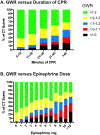Duration and clinical features of cardiac arrest predict early severe cerebral edema
- PMID: 32590271
- PMCID: PMC7733324
- DOI: 10.1016/j.resuscitation.2020.05.049
Duration and clinical features of cardiac arrest predict early severe cerebral edema
Abstract
Background: Severe brain edema appears early after cardiopulmonary resuscitation (CPR) in a subset of patients and portends a poor prognosis. We tested whether clinical features of patients or resuscitation during out-of-hospital cardiac arrest (OHCA) are associated with early, severe cerebral edema.
Method/research design: We reviewed pre-hospital and hospital records for comatose patients surviving to hospital admission after OHCA who had computed tomography (CT) of brain at the time of hospital admission available for inspection. We measured the gray-white ratio (GWR) of X-ray attenuation between the caudate nucleus and posterior limb of the internal capsule, defining severe cerebral edema as GWR < 1.20. We calculated associations between severe cerebral edema and patient or resuscitation variables.
Results: Between 2010 and 2019, 1340 subjects were admitted of whom 296 (22%) showed severe cerebral edema on initial CT. Subjects with severe edema had lower survival (5/296, 2% vs. 377/1044, 36%). Severe edema was independently associated with total CPR duration, total dose of epinephrine, younger age, non-shockable arrest rhythms, fewer total number of rescue shocks, rearrest after initial return of pulses, and non-cardiac arrest etiology. Prevalence of severe cerebral edema increased from 2% among subjects with 0-10 min of CPR to 31% among subjects with >40 min of CPR.
Conclusion: CPR duration along with easily measurable clinical and resuscitation characteristics predict early severe cerebral edema after OHCA. Future interventional trials should consider targeting or preventing cerebral edema after prolonged hypoxic-ischemic brain injury especially in patients with high risk clinical features.
Keywords: Cerebral edema; Imaging; Prognostication.
Copyright © 2020 Elsevier B.V. All rights reserved.
Figures


References
-
- Nolan JP, Neumar RW, Adrie C, et al. Post-cardiac arrest syndrome: epidemiology, pathophysiology, treatment, and prognostication. A Scientific Statement from the International Liaison Committee on Resuscitation; the American Heart Association Emergency Cardiovascular Care Committee; the Council on Cardiovascular Surgery and Anesthesia; the Council on Cardiopulmonary, Perioperative, and Critical Care; the Council on Clinical Cardiology; the Council on Stroke. Resuscitation. 2008;79: 350–379. - PubMed
-
- Cronberg T, Lilja G, Horn J, et al. Neurologic Function and Health-Related Quality of Life in Patients Following Targeted Temperature Management at 33°C vs 36°C After Out-of-Hospital Cardiac Arrest: A Randomized Clinical Trial. JAMA Neurol. 2015; 72: 634–41. - PubMed
-
- Keijzer HM, Hoedemaekers CWE, Meijer FJA, Tonino BAR, Klijn CJM, Hofmeijer J. Brain imaging in comatose survivors of cardiac arrest: Pathophysiological correlates and prognostic properties. Resuscitation. 2018;133:124–136. - PubMed
Publication types
MeSH terms
Substances
Grants and funding
LinkOut - more resources
Full Text Sources
Medical

